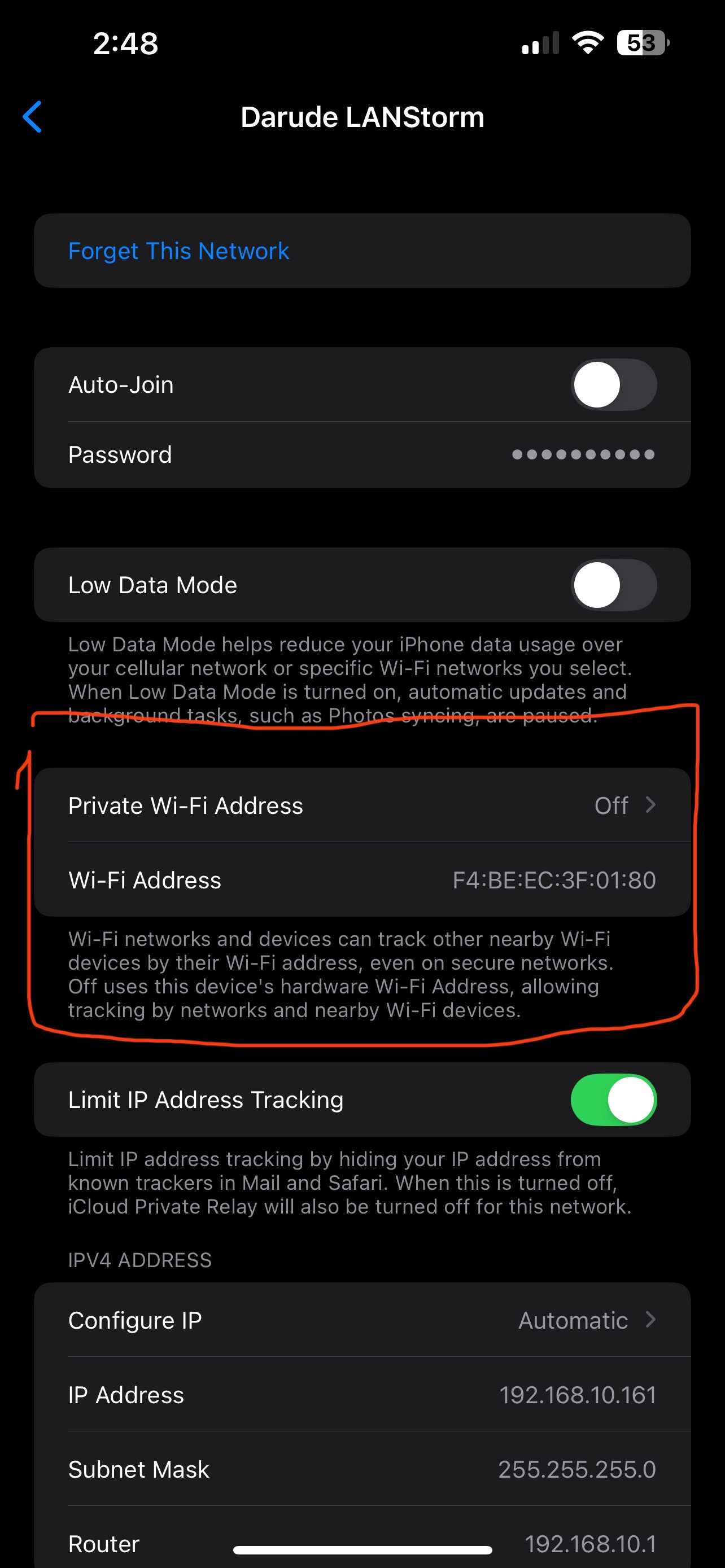Asking for clarification as what I’ve read suggests yes, but is also sometimes coupled with advice to (still?) set a static IP outside of the DHCP address range as well.
Thanks in advance!
I would suggest not to rely on that. Give the DHCP a range, use manual IPs outside of that range
You should put fixed IP addresses outside the DHCP allocation range. While a DHCP server might be smart enough to exclude a fixed address automatically, this is not a must. So better safe than sorry.
If it doesn’t, I would consider that a bug in the router.
Routers are not particularly known for being free of bugs.
Only reserve IPs that are outside of the DHCP range you’ve configured.
the best practice is to keep your dhcp pool and reservations from overlapping, but on a home network its usually easier to let a device acquire an ip via dhcp and then create the reservation for that address.
Someone who might be more familiar with MacOs and iOS please correct me if I’m wrong but i think if certain settings are turned on they will periodically randomize their MAC addresses for security/privacy.
I’m running pihole in a docker container and set the IP to be static on the router. After either a reboot or the update to Sequoia (or both?) The IP address chsnged due to a new MAC address and broke my pihole settings until i updated it.
Apple will randomize your MAC when connecting to networks to maintain privacy. It’s a per-network setting that can be toggled off for your own private network if you want to.

Ah okay, i remember that setting in iOS. Will check the network setting on my Mac Mini to see if thats an option.
Love the network name lol.
Did I age myself there?
I usually move static assignments outside the DHCP range, but in general, most routers will avoid re-allocating it even if it’s within the DHCP range.
DHCP, when set up properly, makes for less work. Reservations will have the DHCP server hand out the same IP to the same hardware (MAC address) when it asks. If you have a device that is from the dinosaur age that doesn’t play nice with DHCP, then make sure you give it an address that is outside the DHCP range on the same subnet. ex: Some home routers use 192.168.1.100 to 192.168.1.200 as the dhcp range. Setting anything from 192.168.1.1 (or 2 if the router is on 1) to 192.168.1.99 is fine, as is 192.168.1.201-192.168.1.254 (or 253 if the router is on 254). However, by setting static ips, you have to remember those ips specifically to interconnect devices on the lan, whereas reserving via dhcp allows you to use local dns resolution to connect to devices via their hostname instead. In additon, you run the risk of ip conflicts from forgetting which device has what ip in an increasingly complex system, and if you change internet providers or routers, you have a lot of extra work to do to fix the network settings to get those static ips to connect.
Alternately, just use the link-local ipv6 address to interconnect on the lan. That doesn’t change on most devices, as it is based on the MAC address, and is always reachable on the lan.
Interesting reading the responses here. I set static addresses all the time and have had zero issue over a decade +.
I have never had issues with anu router when setting static inside dhcp range. Adding IP and MAC has always worked. Not saying you won’t have issues, just I haven’t yet
I use Technitium DNS as both my DHCP and DNS Server on my network. I then have my ISP Router’s DHCP turned off, and point the primary DNS IP To Technitium’s on my network. I have roughly 66-67 network devices at a given time on my network, mostly wireless. (Think wiFi locks, Lights, Outlets etc) then I have my phones and gaming systems an any given thing.
To manage my IP’s I use an Airtable type of database via BaseRow, also self hosted. Through my router’s records, I copied/pasted every single MAC address I found, into a column in my BaseRow table there, and then added the device name or friendly name to another with an assigned IP I want to use. I have a more organized system of ranges 192.168.1.1-10 is mobile devices, 192.168.1.11-30 is IoT etc…
By having my network setup in this fashion, I accomplish a few things, all new devices which power on or connect to the router to get their IP assignment fail to get it since it’s turned off there, and they search the network for an available DHCP Server which lands squarely on the TechnitiumDNS server and are assigned it through there. I also have adblocking enabled through the same server so I have a more home wide adblock which works. (You’d be amazed at how much Telemetry a TV Sends out for every single remote keypress!) I have been able to block those with the adblock enabled. With the DNS server, you can also assign DHCP ranges address, it is really an overly complex server and probably overkill for a home network. I’ve only scratched the surface of what it can do.
If you don’t want to fuss with TechnitiumDNS, there’s AdguardHome, or even PiHole you can use if you want to block Ads (or you can simply disable that function) and those also act as a DHCP Server.
Or, if you are wanting to spend a few hours configuring it, you could run your own DHCP Server in a VM or dedicated device such as a Raspberry Pi.
With all of these settings, it’s important to set your DHCP lease offer long enough that if you have to reboot the DHCP Server for kernel update, or it crashes, you won’t have any devices fail as some do regular polling to check for connectivity (My Linux computer does this a lot). I don’t remember if it’s KDE or Arch. Anyway, running the DNS Server also allows you to custom build your own “domain” system if you will. So could assign maybe your self hosted Calendar for example to http://calendar.local or http://calendar.internal.
By setting up a dedicated DHCP Server, using the manual method or one of the different AdBlock systems, you can also turn off DHCP registration for ‘foreign’ devices or those which aren’t in your DHCP table. This offers a small element of extra security for your WiFi, but it’s not 100% secure if someone knows your IP ranges and Subnet Mask. Also, this will make it easier in the future for you if you upgrade your router or replace it as there’s just two settings to change. (DCHP Server off and the optional self hosted DNS).





